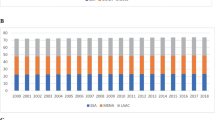Abstract
In their catching-up processes, less developed countries face inter-country barriers which hamper their efforts to imitate the technologies of advanced countries. These international barriers to entry can be traced back to differences in the institutions supporting technological advancement and to the physical and intangible resources necessary for the creation of new competences. In less developed countries, these international barriers aggravate the barriers to entry at the sectoral level and, together, they constitute the generalized barriers to entry. In our paper, we extend a model of economic growth by the entry of new sectors by including these international barriers and show how widening development gaps describing the differences in general income and employment trends can emerge in an auto-catalytic process.












Similar content being viewed by others
References
Abernathy WJ, Utterback JM (1975) A dynamic model of process and product innovation. Omega 3(6):639–656
Arthur WB (1989) Competing technologies, increasing returns, and lock-in by historical events. Econ J 99:116–131
Avnimelech G, Teubal M (2008) Evolutionary targeting. J Evol Econ 18:151–166
Baumol WJ, Panzar JC, Willig RD (1982) Contestable markets and the theory of industry structure. Harcourt, Brace Jovanovich, San Diego
Cantner U, Ebersberger B, Hanusch H, Krüger J, Pyka A (2004) Twin peaks in national income: parametric and non-parametritc estimates. Rev Écon 55(6):1127–1144
Dos Santos T (1973) The crisis of development theory and the problem of dependence in Latin America. In: Bernstein H (ed) Underdevelopment and development. Penguin, London
Dosi G (1982) Technological paradigms and technological trajectories: a suggested interpretation of the determinants and directions of technical change. Res Policy 11:147–162
Frank AG (1967) Capitalism and underdevelopment in Latin America. Monthly Review Press, New York
Freeman C, Perez C (1988) Structural crises of adjustment: business cycles and investment behaviour. In: Dosi G et al (eds) Technical change and economic theory. Pinter, London, pp 38–66
Gerschenkron A (1962) Economic backwardness in historical perspective: a book of essays. Belknap Press of Harvard University Press, Cambridge
Hagedoorn J (1993) Understanding the rationale of strategic technology partnering: interorganizational modes of cooperation and sectoral differences. Strateg Manage J 14:371–385
Hagedoorn J (1995) Strategic technology partnering during the 1980s: trends, networks and corporate patterns in non-core technologies. Res Policy 24:207–231
Jovanovic B, MacDonald G (1994) The life cycle of a competitive industry. J Polit Econ 102:322–347
Klepper S (1996) Entry, exit, growth and innovation over the product life cycle. Am Econ Rev 86:562–583
Klepper S, Simons KL (2005) Industry shakeouts and technological change. Int J Ind Organ 23(1–2):23–43
Nelson RR (1994) Economic growth via the co-evolution of technologies and institutions. In: Leydesdorff L, Von Besselaar P (eds) Evolutionary economics and chaos theory: new directions in technology studies. Pinter, London
Nelson RR (2008) What enables rapid economic progress: what are the needed institutions? Res Policy 37:1–11
Nelson R, Sampat B (2001) Making sense of institutions as a factor shaping economic performance. J Econ Behav Organ 44:31–54
North D (1990) Institutions, institutional change, and economic performance. Cambridge University Press, Cambridge
Pasinetti LL (1981) Structural change and economic growth. Cambridge University Press, Cambridge
Pasinetti LL (1993) Structural economic dynamics. Cambridge University Press, Cambridge
Perez C (1983) Structural change and the assimilation of new technologies in the economic system. Futures 15:357–375
Perez C (2002) Technological revolutions and financial capital: the dynamics of bubbles and golden ages. Edward Elgar, Cheltenham
Perez C (2007) Finance and technical change: a long-term view. In: Hanusch H, Pyka A (eds) The Elgar companion to neo-Schumpeterian economics. Edward Elgar, Cheltenham, pp 820–839
Rostow W (1960) The process of economic growth. Oxford University Press, Oxford
Saviotti PP (1996) Technological evolution, variety and the economy. Edward Elgar, Cheltenham
Saviotti PP, Pyka A (2004a) Economic development by the creation of new sectors. J Evol Econ 14(1):1–36
Saviotti PP, Pyka A (2004b) Economic development, qualitative change and employment creation. Struct Chang Econ Dyn 15:265–287
Saviotti PP, Pyka A (2008a) Micro and macro dynamics: industry life cycles, inter-sector coordination and aggregate growth. J Evol Econ 18:167–182
Saviotti PP, Pyka A (2008b) Product variety, competition and economic growth. J Evol Econ 18:323–347
Saviotti PP, Pyka A (2009) The co-evolution of technologies and financial institutions. In: Pyka A et al (eds) Recent advances in neo-schumpeterian economics, essays in Honour of Horst Hanusch. Edward Elgar, Cheltenham, pp 81–100
Saviotti PP, Catherine D (2008) Innovation networks in biotechnology. In: Patzelt H, Brenner T, Audretsch DB (eds) Handbook of bioentrepreneurship. Springer, Heidelberg
Saviotti PP, Pyka A, Krafft J (2007) On the determinants and dynamics of industry life cycles. mimeo
Schumpeter J (1934, original edition 1912) The theory of economic development. Harvard University Press, Cambridge
Utterback J, Suarez F (1993) Innovation, competition and industry structure. Res Policy 22:1–21
Author information
Authors and Affiliations
Corresponding author
Rights and permissions
About this article
Cite this article
Saviotti, P.P., Pyka, A. Generalized barriers to entry and economic development. J Evol Econ 21, 29–52 (2011). https://doi.org/10.1007/s00191-010-0184-2
Published:
Issue Date:
DOI: https://doi.org/10.1007/s00191-010-0184-2




